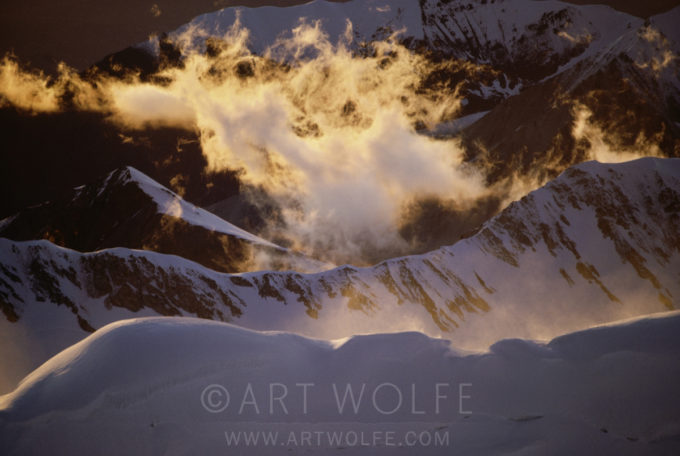Flashback Friday: Denali 1988
This excerpt is from “Photographs from the Edge”, which not only details the stories behind some of my most well-known captures from across the globe and throughout my career, but is also filled with tips and tricks and equipment information.
August 1988: “Rising Mist”, Alaska Range, Denali National Park, Alaska USA
Nikon F3, Nikkor 200-400mm f/5.6 lens, f/8 for 1/250 sec., Kodachrome 64
The nature of the photo: Mountains are well known for their fast rising and falling air along their slopes. Glider pilots in mountainous areas will fly right at a mountain side when the thermals are right, then catch a fast moving ride going up with the air. They often describe this as running and jumping onto an elevator that is already moving upward.

Years ago I was working on a book entitled Alakshak, The Great Country, a Sierra Club book about Alaska. I spent a lot of time crisscrossing Alaska gathering photos for it. As part of this journey, I wanted to get some aerial shots of mountains in the Alaska Range. So I found myself in a small plane above the mountains working in the hours between 11 pm through 1 am.
In the summer, this is a key time because the light is most dramatic then. During summer solstice in Alaska, most of the day is bright sunshine and you only have a few hours of twilight with bold light and color. I was using the shortest hours of the day to capture the most radical light.
In this image, the light of the sun on the Arctic horizon illuminating a few misty cloud sweeping up a slope at around 18,000 feet. While I like this image and I have long loved photographing mountains, it is not the photo itself that brings back memories of this moment. This was shot over 25 years ago, and I remember it all these years later because of the absolute turbulence that our plane would encounter as the plane would fly long the lip of the ridge.
I fly a lot, and I have been on planes around the world in some very remote locations. However, I’m not a happy camper when the plane drops 20 feet in an instant as it was doing here. I can often circle in ever tighter circles around the subject with my mind so focused on the shooting that being scared is not part of the equation. However, when a plane is dropping and rising with the thermals like this, it is uncomfortable at best and frightening usually.
I remember spot metering the brightest part of the frame which was simply the wispy cloud. I compensated for the brightness by exposing to make that cloud bright with detail. By contrast then the surrounding mountains and distant valley remain fairly dark by comparison. This shot shows off the ephemeral nature of clouds and light. Within seconds of shooting this, the sun dropped below the horizon, and the entire moment was gone in an instant.
Photo tip: Spot metering can be a helpful technique when the light is dramatic and you have to be sure you get the brightness values right. In this shot, spot metering determined the exposure for the bright cloud, but that would have meant the clouds were dark and the rest of the scene even darker. That exposure has to be adjusted to make the clouds bright, not dark, by adding exposure to what the meter shows.
For this and many, many more stories behind some of the most notable photographs from a lifetime of world travel, pick up “Photographs From the Edge“ today and make a note at checkout that you’d like me to sign it!


Leave a Reply